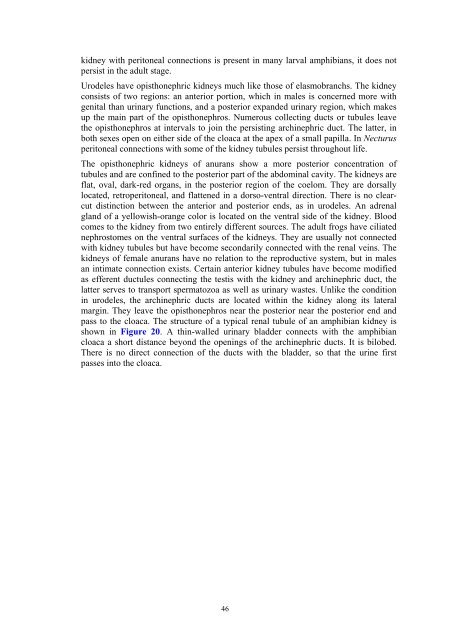Animal Diversity: Chordata
Animal Diversity: Chordata
Animal Diversity: Chordata
Create successful ePaper yourself
Turn your PDF publications into a flip-book with our unique Google optimized e-Paper software.
kidney with peritoneal connections is present in many larval amphibians, it does not<br />
persist in the adult stage.<br />
Urodeles have opisthonephric kidneys much like those of elasmobranchs. The kidney<br />
consists of two regions: an anterior portion, which in males is concerned more with<br />
genital than urinary functions, and a posterior expanded urinary region, which makes<br />
up the main part of the opisthonephros. Numerous collecting ducts or tubules leave<br />
the opisthonephros at intervals to join the persisting archinephric duct. The latter, in<br />
both sexes open on either side of the cloaca at the apex of a small papilla. In Necturus<br />
peritoneal connections with some of the kidney tubules persist throughout life.<br />
The opisthonephric kidneys of anurans show a more posterior concentration of<br />
tubules and are confined to the posterior part of the abdominal cavity. The kidneys are<br />
flat, oval, dark-red organs, in the posterior region of the coelom. They are dorsally<br />
located, retroperitoneal, and flattened in a dorso-ventral direction. There is no clearcut<br />
distinction between the anterior and posterior ends, as in urodeles. An adrenal<br />
gland of a yellowish-orange color is located on the ventral side of the kidney. Blood<br />
comes to the kidney from two entirely different sources. The adult frogs have ciliated<br />
nephrostomes on the ventral surfaces of the kidneys. They are usually not connected<br />
with kidney tubules but have become secondarily connected with the renal veins. The<br />
kidneys of female anurans have no relation to the reproductive system, but in males<br />
an intimate connection exists. Certain anterior kidney tubules have become modified<br />
as efferent ductules connecting the testis with the kidney and archinephric duct, the<br />
latter serves to transport spermatozoa as well as urinary wastes. Unlike the condition<br />
in urodeles, the archinephric ducts are located within the kidney along its lateral<br />
margin. They leave the opisthonephros near the posterior near the posterior end and<br />
pass to the cloaca. The structure of a typical renal tubule of an amphibian kidney is<br />
shown in Figure 20. A thin-walled urinary bladder connects with the amphibian<br />
cloaca a short distance beyond the openings of the archinephric ducts. It is bilobed.<br />
There is no direct connection of the ducts with the bladder, so that the urine first<br />
passes into the cloaca.<br />
46

















